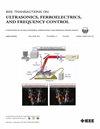Beamformer for a Lensed Row–Column Array in 3-D Ultrasound Imaging
IF 3.7
2区 工程技术
Q1 ACOUSTICS
IEEE transactions on ultrasonics, ferroelectrics, and frequency control
Pub Date : 2025-01-06
DOI:10.1109/TUFFC.2025.3526523
引用次数: 0
Abstract
Row-column (RC) arrays typically suffer from a limited field of view (FOV), with the imaging area confined to a rectangular region equal to the footprint of the probe. This limitation can be solved by using a diverging lens in front of the probe. Previous studies have introduced a thin lens model for beamforming lensed RC arrays, but this model inaccurately assumes the lens to be infinitely thin, leading to degraded resolution and contrast due to errors in the time of flight (TOF) calculations. This article presents a beamformer based on ray tracing for accurate TOF calculation. A Verasonics Vantage 256 scanner was equipped with a Vermon RC probe with用于三维超声成像的透镜行-列阵列波束形成器
行-列(RC)阵列通常受到有限的视场(FOV)的影响,成像区域被限制在一个矩形区域,等于探头的足迹。这一限制可以通过在探头前使用发散透镜来解决。先前的研究已经引入了一种用于波束形成透镜RC阵列的薄透镜模型,但该模型不准确地假设透镜无限薄,导致由于飞行时间(TOF)计算误差而导致分辨率和对比度下降。本文提出了一种基于光线追踪的波束形成器,用于精确的TOF计算。Verasonics Vantage 256扫描仪配备了一个具有${128}+{128}$元素、$\lambda $ pitch和${6}~\textit {MHz}$中心频率的Vermon RC探头。采用96个虚拟源和32个有效元的合成孔径超声序列,每个发射采用行元,所有柱元采集数据。用球形聚苯乙烯(PS)透镜和双圆柱形聚甲基丙烯酸甲酯(PMMA)透镜对该方法进行了测试。基于压力场测量,这两个透镜分别提供20°和33°的视场。薄透镜模型的横向分辨率约为$17.4\lambda $,而新方法的分辨率约为$3.8\lambda $,提高4.6倍。在保留视场的情况下,双圆筒形透镜的对比度从23.1提高到29.8 dB。
本文章由计算机程序翻译,如有差异,请以英文原文为准。
求助全文
约1分钟内获得全文
求助全文
来源期刊
CiteScore
7.70
自引率
16.70%
发文量
583
审稿时长
4.5 months
期刊介绍:
IEEE Transactions on Ultrasonics, Ferroelectrics and Frequency Control includes the theory, technology, materials, and applications relating to: (1) the generation, transmission, and detection of ultrasonic waves and related phenomena; (2) medical ultrasound, including hyperthermia, bioeffects, tissue characterization and imaging; (3) ferroelectric, piezoelectric, and piezomagnetic materials, including crystals, polycrystalline solids, films, polymers, and composites; (4) frequency control, timing and time distribution, including crystal oscillators and other means of classical frequency control, and atomic, molecular and laser frequency control standards. Areas of interest range from fundamental studies to the design and/or applications of devices and systems.

 求助内容:
求助内容: 应助结果提醒方式:
应助结果提醒方式:


